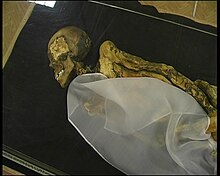| Revision as of 21:34, 9 July 2013 edit78.184.199.68 (talk)No edit summary← Previous edit | Revision as of 17:18, 12 December 2013 edit undoMrliebeip (talk | contribs)48 edits adding new section: Genetic compostionNext edit → | ||
| Line 5: | Line 5: | ||
| Other kurgan cemeteries associated with the culture include those of ], ], ], ] and ]. There are so far no known sites of settlements associated with the burials, suggesting a purely nomadic lifestyle. | Other kurgan cemeteries associated with the culture include those of ], ], ], ] and ]. There are so far no known sites of settlements associated with the burials, suggesting a purely nomadic lifestyle. | ||
| ==Genetic composition== | |||
| The gene pool of the inhabitants of the ] ] site during the ] was similar to that of western Iron Age Altaians (] and ]). Following results were brought in knowledge: | |||
| {{cquote|"Thus, this people not only shared the same culture (Pazyryk), but also shared the same genetic east-west population admixture. In turn, Pazyryks appear to have a similar gene pool that current ].<ref>Mercedes González-Ruiz et al. ''Tracing the Origin of the East-West Population Admixture in the Altai Region (Central Asia)''. PLoS ONE 7(11): e48904. ]:</ref>}} | |||
| ==See also== | ==See also== | ||
Revision as of 17:18, 12 December 2013

The Pazyryk culture is an Iron Age archaeological culture (ca. 6th to 3rd centuries BC) identified by excavated artifacts and mummified humans found in the Siberian permafrost in the Altay Mountains and nearby Mongolia. The mummies are buried in long barrows (or "kurgans") similar to the tomb mounds of western Scythian culture in modern Ukraine. The type site are the Pazyryk burials of the Ukok Plateau.(NOVA 2007) Many artifacts and human remains have been found at this location, including the Siberian Ice Princess, indicating a flourishing culture at this location that benefited from the many trade routes and caravans of merchants passing through the area.(State Hermitage Museum 2007) The Pazyryk are considered to have had a war-like life.(Jordana 2009)
Other kurgan cemeteries associated with the culture include those of Bashadar, Tuekta, Ulandryk, Polosmak and Berel. There are so far no known sites of settlements associated with the burials, suggesting a purely nomadic lifestyle.
Genetic composition
The gene pool of the inhabitants of the Mongolian Altai site during the Iron Age was similar to that of western Iron Age Altaians (Russia and Kazakhstan). Following results were brought in knowledge:
"Thus, this people not only shared the same culture (Pazyryk), but also shared the same genetic east-west population admixture. In turn, Pazyryks appear to have a similar gene pool that current Altaians.
See also
Notes
- Mercedes González-Ruiz et al. Tracing the Origin of the East-West Population Admixture in the Altai Region (Central Asia). PLoS ONE 7(11): e48904. doi:10.1371/journal.pone.0048904
. doi:10.1016/j.jas.2009.01.008. {{cite journal}}: Cite journal requires |journal= (help); Missing or empty |title= (help)
NOVA (2007). "Ice Mummies: Siberian Ice Maiden". PBS - NOVA. Retrieved 2007-07-31.
State Hermitage Museum (2007). "Prehistoric Art - Early Nomads of the Altaic Region". The Hermitage Museum. Retrieved 2007-07-31.
External links
- Nomadic Art of the Eastern Eurasian Steppes, an exhibition catalog from The Metropolitan Museum of Art (fully available online as PDF), which contains material on Pazyryk culture